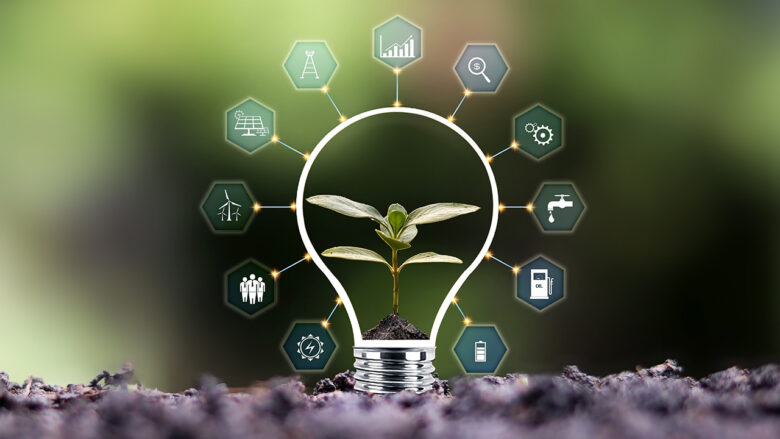A new field of technology that has emerged due to the urgent need to protect the environment is called “green technology.” The field brings together new ideas and environmental concerns, driving the global search for better, more sustainable solutions to key problems such as pollution, climate change, and resource loss. In this blog, we explore how technology is transforming businesses so they can thrive in an environmentally friendly way. We discuss new developments in green technologies, such as smart agriculture and renewable energy, that show how we can make the future better and more sustainable.
What Sustainable Innovation Enables
The idea of sustainable development through innovation is to create tools and systems that meet the needs of the present without making it harder for future generations to meet their own . The main goals of green technology are to reduce carbon emissions, conserve resources, and eliminate waste. These new ideas are designed to keep the environment in balance in the long term while also stimulating economic development by lowering energy costs and opening up new markets. Governments, the scientific community, and forward-thinking companies are building the infrastructure needed to develop renewable energy sources while minimizing environmental damage. This effort has paved the way for major changes in many sectors.
Renewable Energy Technologies
When it comes to sustainability, the renewable energy sector is leading the way. Hydroelectric power plants, solar panels, and wind turbines are becoming increasingly user-friendly and efficient. For example, solar energy has undergone a major transformation over the years thanks to the development of more efficient and cheaper perovskite solar cells. Similarly, offshore wind farms use stronger, more consistent winds to produce more electricity. New developments in hydropower use water currents and tides to capture kinetic energy. Each new development shows how green energy is bringing us closer to a carbon-free future. This applies to electricity from industry, but also to everyday applications such as heating homes and driving electric vehicles.
Advances in Energy Storage
With the rise of green energy, a major question arises: how can we efficiently store and deliver energy when the wind isn’t blowing or the sun isn’t shining? Better forms of energy storage, such as lithium-ion batteries, flow batteries, and even hydrogen fuel cells, are making this problem easier to solve. Energy storage is changing the way people use green energy. It’s providing a more stable and reliable supply of energy to the grid. Companies are also investing in large-scale energy storage projects to ensure a constant supply of energy, even when production is low. The move makes it easy and reliable for consumers to access clean energy, and it’s encouraging many companies to do the same.
Food Technology and Sustainable Agriculture
Food and agriculture are two of the key sectors where green technology is making great strides. Due to issues such as food security and resource depletion, the region needs innovations focused on sustainability. Vertical farming, for instance, enables plants to grow indoors with adequate light and minimal water. This makes it possible to grow food in cities. Lab-grown meat and plant-based protein alternatives from companies like Impossible Foods and Beyond Meat are also making it easier for livestock farmers to make a profit while reducing methane emissions. Farmers can now use drones, artificial intelligence, and precision agriculture to optimize water resources, predict crop yields, and even control pests in ways that don’t harm the environment, ensuring that food is produced in an environmentally friendly way.
Green Building and Construction
The residential and construction industries are also investing heavily in sustainability. Green building technologies are driving new building designs in locations that use less energy. Green buildings use reusable, recyclable, and even carbon-negative materials such as bamboo, wood, concrete, and mycelium. The industry is moving toward net-zero energy through better insulation, rainwater harvesting systems, and smart HVAC systems. Prefabricated modular buildings can also reduce waste and accelerate the construction process. Not only do these buildings save residents money on energy bills, they also significantly reduce greenhouse gas emissions from the construction industry.
The Role of AI and the IoT in Green Environmental Protection
The Internet of Things (IoT) and artificial intelligence (AI) are two of the key innovations driving the growth of green technology. We are using AI programs trained on very large datasets to improve green energy forecasting, enhance grid performance, map deforestation, and even predict weather patterns. On the other hand, IoT devices are making homes and businesses more energy efficient by automating tasks such as controlling lighting and temperature. Smart cities with connected energy systems are becoming test beds for AI- and IoT-based sustainability projects, reducing energy waste and making better use of resources.
Challenges and Opportunities of Green Technology
While green technology has enormous potential, it also faces many challenges, such as limited technology and high costs. Many eco-friendly ideas, such as biofuels and advanced solar cells, are expensive to develop and deploy at scale. Legal barriers and unfair government policies can also slow adoption. However, these challenges also bring new opportunities. The rapid growth of the renewable energy market shows that advances in green technology often pay off. The green economy is increasingly gaining support from governments and businesses around the world. Ways to achieve these goals include providing subsidies, tax breaks, and public-private partnerships to make it easier for companies to adopt environmentally friendly practices.
The Future of Green Technology
Green technology is promising and has the potential to dramatically change the way society functions. New technologies such as carbon capture and storage, eco-friendly irrigation projects, and bioengineered natural resources promise a future where business innovation and environmental health work together. More and more people are interested in the circular economy, recycling resources, and reducing waste. This shows that green technology can become an important part of global business. New technology shows that making money and green business do not have to be mutually exclusive. Instead, they can work together to make the world fairer and healthier.
The Long-Term Impact of Green Technology
Green technology can only succeed in the long term if governments, innovators, mentors, and ordinary citizens work together. A healthy, green ecosystem requires continued research, development funding, and informed consumers. This collaborative approach can ensure that the world prioritizes health and happiness over wasteful growth. With the right investments and new ideas emerging, green technology will not only change business but also the way we live and interact with nature.
FAQs
1. Why is it important to use green technology?
Green technology is important because it helps address growing environmental issues such as climate change, pollution, and resource scarcity. By using sustainable methods, you can reduce carbon emissions, protect natural ecosystems, and keep the economy moving.
2. How can businesses benefit from green technology?
Businesses can use green technology by purchasing machines that use less energy, environmentally friendly energy sources, eco-friendly packaging, and Internet of Things (IoT) devices. This allows them to better manage their resources. It is also a beneficial idea to work with suppliers who care about the environment and measure their carbon footprint daily.
3. Which sectors benefit the most from green technologies?
While every sector can benefit, we see the biggest gains in energy, agriculture, transportation, and construction. By using green technologies, they can reduce pollution, operate more efficiently, and save money.




